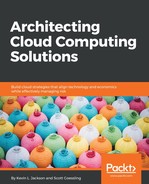The cloud provider network holds many of the key application and API services. The Cloud application component represents cloud-native applications that have been designed and developed within the cloud environment. These applications normally use modern techniques such as micro services architecture, lightweight run times, container technology, and DevOps methodologies. The application's services are often exposed using APIs and may need to access data from other systems via API calls, messaging, and data integration services.
Interaction APIs provide access to enterprise capabilities. They are maintained by the lines of business and are composed from lower-level system APIs. These APIs are business-led, may be exposed externally, and might even be monetized with a funding model based on their usage. This component is the API gateway into the enterprise network. The interaction APIs also advertises the available services endpoints to which the cloud application has access. This component provides API discovery, catalogs, and connection of offered APIs to service implementations and management capabilities, such as API versioning.
Cloud messaging gives fast, scalable, high throughput event delivery services with the enterprise network. This component should support multiple open event protocols. It should also abstract away any proprietary non-standard protocols of the enterprise messaging. This component is the event gateway into the enterprise network and should be able to do the following:
- Enable large-scale message processing
- Support a microservices framework and event-driven applications
- Enable hybrid messaging
- Perform batch and real-time analytics
- Accelerate applications and data integration
Cloud integration services deliver rapid, simple, and flexible integration capabilities. Unlike traditional Enterprise Application Integration (EAI) and ETL solutions, this component provides simple integration tooling with targeted capabilities. Customization is done performed via configuration and not by writing software code. This component is the gateway into SoR within the enterprise network and includes the following:
- Preparing/moving data to the cloud
- Extending business operations
- Accessing mainframe data and services
- Maintaining data consistency across applications
- Connecting on-premises apps and data to the cloud
The transformation and connectivity component enables secure enterprise connections. This component includes the following capabilities:
- Enterprise secure connectivity
- Transformation
- Enterprise data connectivity
